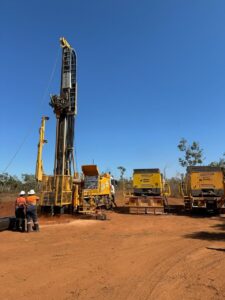
Serra Drilling is a family-owned and operated company based in the Atherton Tablelands, North Queensland. Established in 1970, the business has provided specialist drilling services across Queensland and interstate for over five decades. Serra Drilling employs both highly experienced water wells and exploration drillers. With deep expertise and state-of-the-art equipment, the company consistently delivers some of the most technically challenging drilling programs safely and efficiently. The company takes pride in the quality of its work and offers clients safe and competitive drilling services.
Their service offering includes large diameter water production bores, dewatering bores, stock and domestic water bores, groundwater monitoring bores, piezometer installations, exploration drilling, and pump testing.
As a third-generation business operating across multiple sectors, including mining, agriculture, construction, and government, Serra Drilling required a streamlined, reliable, and cost-effective system to manage safety and compliance documentation across geographically dispersed and fast-moving projects.
Their previous systems were fragmented, with manual paper forms often getting lost in trucks or failing to return to the office. Digital tools they had previously considered or trialled were either too complex, too expensive, or poorly suited for small to mid-sized operators.
In March 2023, Serra Drilling turned to Mackay Safety and implemented the 4PS Software suite after a successful demonstration, comprising their:
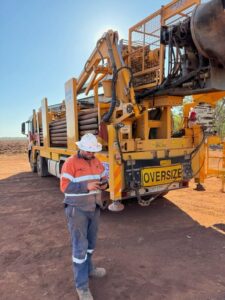
• Safety management plan
• Membership and advisory support
• 4PS Software core system including 4P Forms
• 4PS mobile app
• Dropbox integration.
This integrated solution allowed the team to digitise safety forms, sync field data with the office, track asset maintenance, manage certificates, and easily share records with clients — all while keeping the system cost-effective and user-friendly for their team. The 4PS software installed from Mackay Safety was customised to Serra Drilling’s specific needs and is continually updated to ensure relevancy and apply the latest technological advancements.
Since partnering with Mackay Safety and implementing the 4PS Software system, Serra Drilling has transformed its approach to safety, compliance, and operations, achieving significant gains in efficiency, productivity, and peace of mind.
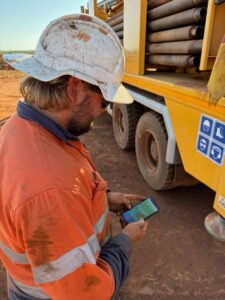 A standout achievement has been gaining ISO certification – a feat the company had never attempted before due to the complexity and manual nature of its previous systems. ISO certification formally recognises that a business meets internationally agreed standards for consistency, reliability, and quality, developed by the International Organisation for Standardisation (ISO). It’s a strong trust signal for clients in sectors such as mining, construction, and government – and is often essential for winning contracts.
A standout achievement has been gaining ISO certification – a feat the company had never attempted before due to the complexity and manual nature of its previous systems. ISO certification formally recognises that a business meets internationally agreed standards for consistency, reliability, and quality, developed by the International Organisation for Standardisation (ISO). It’s a strong trust signal for clients in sectors such as mining, construction, and government – and is often essential for winning contracts.
With the support of Mackay Safety, Serra Drilling successfully passed an independent audit and gained recognition for its compliance.
“We probably wouldn’t have applied for ISO accreditation if it weren’t for 4PS and Mackay Safety,” said Serra Drilling General Manager, Mark Serra. “With our previous systems, it would have taken five years to achieve the level of documentation needed – if it happened at all.”
The operational impact has been equally impressive. By digitising safety processes and automating reporting, Serra Drilling has avoided the need to hire extra administration or safety staff.
“We’d need another full-time safety person in the office to do what we’re doing now at minimum, and that’s easily one salary saved at around $150,000,” Mark said.
Productivity has soared. The team now handles four times the volume of safety, compliance, and reporting work, all achieved without expanding the workforce.
“We’re doing four times the amount of work with the same people.”
 Real-time reporting has improved response times across projects, with incidents reported instantly via the app.
Real-time reporting has improved response times across projects, with incidents reported instantly via the app.
“I’ll get an incident report via email from the app before I even get a phone call.”
Asset maintenance has become more efficient, with automated links between field reports, asset registers, and certificate renewals.
“The system helps us manage both maintenance and safety – two critical aspects of our business.”
According to Mark, what truly sets 4PS Software apart is the hands-on service and customisation Mick and his team at Mackay Safety provide.
“We pay for what we need with Mackay Safety — and sometimes what has been developed to assist us helps other companies and vice versa. It works incredibly well,” Mark said.
This collaborative and tailored approach has been key to Serra Drilling’s long-term success with the platform.
“4PS Software and Mackay Safety’s support services have changed the way we do business. The system is user-friendly, has saved us time and money, and has helped us achieve ISO certification. Our productivity has quadrupled – and we didn’t need to hire anyone new to achieve this.”
--
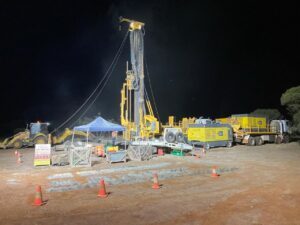 Thank you to Mark Serra for sharing his experience with Mackay Safety and 4PS software.
Thank you to Mark Serra for sharing his experience with Mackay Safety and 4PS software.
Contact Mackay Safety today on 07 4944 1272 or explore the website to learn more about how we can support your operations with services and technology that ensure you keep on top of your safety and compliance requirements.
As many businesses discover, not only is workplace health and safety (WHS) compliance a legal obligation; it’s a critical aspect of fostering a safe and productive work environment.
Proactive WHS management helps businesses reduce the risk of accidents, enhance employee well-being, and improve overall operational efficiency.
By prioritising WHS, organisations can build trust among their workforce, reduce downtime from incidents, and avoid costly penalties or reputational damage.
A commitment to proactive WHS compliance is an investment in the longevity and success of any business.
In this article, Mackay Safety explores the best practices for WHS compliance and provides advice about how to engage in workplace hazard prevention.
Modern workplaces face a variety of hazards, ranging from physical risks like slips, trips, and falls to ergonomic challenges caused by prolonged desk work.
Other common risks include exposure to hazardous substances, electrical hazards, and mental health stressors.
Identifying these hazards early is crucial to creating an environment where employees feel secure and protected.
Regular workplace assessments and open communication between management and staff play an essential role in mitigating these risks.
Additionally, implementing comprehensive training programs ensures employees are equipped to handle potential dangers, fostering a culture of safety and well-being.
By addressing both physical and psychological risks, organisations can promote productivity and morale while reducing the likelihood of incidents.
Risk management tools are indispensable in identifying and addressing workplace hazards, forming a crucial part of comprehensive risk management strategies.
Tools such as safety audits, hazard identification checklists, and digital incident reporting systems enable businesses to track and manage risks effectively.
These tools also help in prioritising corrective actions and allocating resources where they’re most needed, ultimately reducing the likelihood of incidents.
To minimise risks, organisations should develop and enforce robust safety policies tailored to their specific industries.
Regular safety inspections, clear and visible signage, and the provision of accessible personal protective equipment (PPE) are fundamental practices that support a safe work environment.
Additionally, fostering open communication channels is crucial as it empowers employees to report potential hazards or unsafe conditions without hesitation, creating a culture of share responsibility and continuous improvement.
By prioritising WHS and implementing effective workplace safety practices, organisations can build trust among their workforce, reduce downtime from incidents, and avoid costly penalties or reputational damage.
WHS risk assessment tools, such as digital compliance software, simplify the process of identifying and managing workplace hazards.
These tools allow businesses to assess risks in real time, track corrective actions, and maintain compliance records.
Integrating digital tools into daily operations ensures a proactive approach to workplace safety.
One such powerful tool is Mackay Safety’s 4PS software, which stands for Predict, Prevent, Protect, and Perform.
This software is designed to enhance workplace safety by providing a comprehensive suite of features including real-time risk assessments, automated compliance tracking, and detailed incident reporting.
The predictive analytics component of the 4PS software assists in forecasting potential hazards before they manifest, while the preventive measures help in mitigating risks proactively.
A culture of safety always starts at the top.
Leadership must demonstrate a commitment to WHS compliance by setting clear expectations and leading by example.
Encouraging employee involvement in safety initiatives, such as forming WHS committees, helps instil a shared sense of responsibility for workplace safety.
When leaders actively prioritise safety, it reinforces the importance of adhering to policies and creates a workplace where employees feel valued and protected.
Transparent communication about safety goals and progress fosters trust and ensures everyone understands their role in maintaining a safe environment.
Additionally, recognising and rewarding proactive safety efforts can motivate employees to remain vigilant and engaged in fostering a positive safety culture.
Examples include:
These types of rewards not only reinforce the importance of safety but also foster a positive, engaged work environment where employees feel motivated to contribute.
Comprehensive training programs equip employees with the knowledge and skills to identify and mitigate risks.
Regular refresher courses and hands-on training sessions ensure that safety practices are consistently upheld.
Training also empowers employees to act confidently in emergencies, reducing the potential for injury or damage.
By fostering a culture of continuous learning, businesses can adapt to new safety challenges and maintain a resilient workforce.
The rise of digital tools has revolutionised Workplace Health and Safety compliance.
Platforms for incident reporting, safety training modules, and automated risk assessments streamline processes and improve accuracy.
Real-time data analytics provide insights into trends, enabling businesses to address emerging risks proactively.
By harnessing technological advancements, organisations can not only ensure compliance but also foster a culture of safety that permeates every level of the workforce.
Tracking key performance indicators (KPIs) such as incident rates, near-miss reports, and employee training completion rates helps organisations measure the effectiveness of their WHS initiatives.
In addition to these metrics, it’s beneficial to incorporate both leading and lagging indicators.
Leading indicators, such as the number of safety audits conducted or the frequency of safety meetings, are proactive measures that can predict and prevent incidents.
Lagging indicators, like lost-time frequency rates, reflect past incident and help access the outcomes of safety initiatives.
Regularly reviewing these metrics ensures continuous improvement and demonstrates a commitment to maintaining a safe workplace.
For more detailed guidance on setting and measuring WHS KPIs, Safe Work Australia’s report, Measuring and Reporting on Work Health and Safety, provides a comprehensive framework.
Proactive WHS compliance is essential for minimising workplace risks and fostering a culture of safety.
By recognising common hazards, implementing effective safety practices, leveraging digital tools, and prioritising training and culture, organisations can create a safer and more productive work environment.
Businesses are encouraged to adopt these best practices and invest in the tools and training needed to ensure long-term WHS success.
For tailored guidance and expert support in proactive WHS management, contact Mackay Safety on 07 4944 1272 to help you builder a safer and more resilient workplace.
Mackay Safety helps clients throughout Australia win tenders, provide safety advice, and as safety and risk management experts, they can help steer your business in the right direction even if you’re not sure exactly how to get started.
Westralian Diamond Drillers (WDD) officially got its name in 1965, starting as a humble family business and growing to over 120 employees who provide surface exploration diamond drilling services to the mining sector.
With a growing fleet of ten drill rigs and an extensive array of auxiliary equipment and support vehicles, Westralian Diamond Drillers is a ‘one stop shop’ equipped with all the necessities to undertake a successful exploration and production campaign no matter the geographical location or environment faced before them.
Mitigation of risk is at the forefront of ensuring a safe and successful drilling program is maintained, which is why WDD has continually strived to ensure the safety of all workers and visitors whether that be at the frontline on a drill rig or in the Kalgoorlie yard.
As a company that prides itself on the core values of dedication, trust, transparency, quality of work, and customer satisfaction, several years ago the Kalgoorlie-Boulder company recognised an area of improvement would be to increase the accuracy and efficiency of its on-field reporting.
During the past decade, the safety and compliance reporting required to win tenders and demonstrate due diligence for projects has become increasingly rigorous. Additional checklists meant it was becoming increasingly time-consuming to correct mistakes on digital or manual forms back at the office.
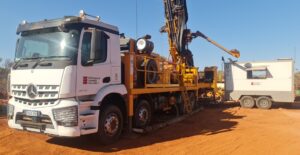 Michael La Machia, Westralian Diamond Drillers’ HSE&T Advisor of more than seven years, said the safety of staff and operating equipment had always been paramount, however tenders and contract reporting needed to be backed by reported evidence that could be passed on to current and prospective clients.
Michael La Machia, Westralian Diamond Drillers’ HSE&T Advisor of more than seven years, said the safety of staff and operating equipment had always been paramount, however tenders and contract reporting needed to be backed by reported evidence that could be passed on to current and prospective clients.
Michael and his team recognised that its paper-based and software systems were resulting in too much human error in the field – particularly from personnel whose primary role was not to do administrative tasks but to provide labour.
As forms for site labourers were not pre-populated with standardised answers, miscommunication could easily occur, including approximately 25% of all mistakes on forms being attributed to typos alone.
 Already familiar with Mackay Safety’s 4PS forms, in 2021 Michael worked with the team at Mackay Safety to develop a PLOD system that would be fit for the reporting requirements of Westralian Diamond Drillers and hard rock drilling.
Already familiar with Mackay Safety’s 4PS forms, in 2021 Michael worked with the team at Mackay Safety to develop a PLOD system that would be fit for the reporting requirements of Westralian Diamond Drillers and hard rock drilling.
Crafted and developed in Australia since 2018, the Intelligent Progressive Log of Drilling (iPlod), also known as DDR/DOR is loaded with advanced features tailored for the exploration drilling industry, including:
iPlod can be complemented with Mackay Safety’s groundbreaking 4PS Software to optimise compliance tracking for:
Additional iPlod features/benefits include:
Michael said: “iPlod is now our daily record for what our drillers do at every shift – telling our clients what they did, what tools and products they used, how many minutes they spent in an area, what products they used, and where the drilling was left at before shift changeover.
“The software automatically sends the daily report to clients, and it does have the ability to invoice clients based on the work performed although we aren’t using that feature yet – instead double-checking accuracy of inputted information back at the office. Using 4PS Forms and the iPlod software through Mackay Safety has helped to make life easier for the staff on the front line and eliminated misunderstandings. The forms have pre-populated information that employees can select from a drop-down menu, and this eliminates most errors.”
Michael said other company’s software packages were considered but were deemed too simple for the job at hand.
“Mackay Safety’s software systems were more complex, which was better, however you don’t need to be tech-savvy to use it either. We like that we can go in and change questions or information in the system ourselves too which is great for efficiency.”
Michael estimated that using Mackay Safety’s software has resulted in 40-50 hours time saved a week across all areas of the business, including 10-20 hours in the safety division alone.
 As the system alerts Westralian Diamond Drilling to maintenance checks, licence and initial aid updates for staff, and drug and alcohol testing, the business can operate proactively rather than reactively.
As the system alerts Westralian Diamond Drilling to maintenance checks, licence and initial aid updates for staff, and drug and alcohol testing, the business can operate proactively rather than reactively.
“Particularly beneficial is our site employees’ ability to upload photos of broken machinery for our maintenance crews to see. You can write down what you think is wrong with a machine when it breaks but really, it’s guess work unless you’re a mechanic. Due to the time involved in ordering parts and travelling to site, having a photo to look at instantly means that our maintenance crews aren’t buying a $600 part when really, they only needed to replace a rubber seal worth $20. And that’s just one example. The software is saving us so much time and money.”
--
Thank you to Michael La Macchia for sharing his experience with Mackay Safety and 4PS software.
Contact Mackay Safety today on 07 4944 1272 or visit our website at mackaysafety.com.au to learn more about how we can support your operations with services and technology that ensure you keep on top of your safety and compliance requirements.
In today’s business landscape, the integration of Workplace Health and Safety (WHS) with Environmental, Social, and Governance (ESG) principles has evolved from being a regulatory necessity to a strategic priority.
Organisations worldwide recognise that WHS is no longer confined to the physical safety of employees but is now a cornerstone of holistic business sustainability.
At the intersection of safety, well-being, and corporate responsibility, ESG principles provide a roadmap for companies aiming to build a safer, more ethical, and sustainable workplace.
This blog explores how ESG principles enhance WHS strategies, the importance of a comprehensive approach to workplace safety, and practical steps for aligning WHS with ESG goals.
ESG principles encompass three core dimensions that measure a company’s sustainability and ethical impact. They are:
Within ESG, the ‘social’ component underscores the importance of creating safe and inclusive workplaces that prioritise employee well-being, diversity, and mental health.
The ‘governance’ dimension focuses on compliance with workplace safety regulations, ethical oversight, and establishing robust WHS policies.
Together, these aspects ensure organisations meet legal obligations while fostering a culture of care and accountability.
Workplace Health and Safety serves as a bridge between the ‘social’ and ‘governance’ pillars.
By embedding WHS into ESG strategies, businesses can demonstrate their commitment to protecting employees, promoting operational resilience, and meeting stakeholder expectations.
This integration not only mitigates risks but also enhances a company’s reputation, investor appeal, and long-term sustainability.
Traditional WHS planning often focuses on compliance with regulatory requirements and addressing immediate hazards. While necessary, this approach may overlook broader organisational goals, such as employee well-being, environmental impacts, and stakeholder engagement.
In contrast, a holistic WHS strategy integrates safety planning into the company’s overall ESG framework.
This approach considers interconnected factors such as workplace culture, sustainability, and employee mental health, creating a comprehensive safety ecosystem that aligns with organisational values.
Adopting a holistic WHS approach aligned with ESG principles offers several benefits:
Environmental risks – such as extreme weather, pollution, or inadequate resource management – directly impact workplace safety.
For instance, industries such as construction or manufacturing must address heat stress, air quality, and hazardous material handling.
Incorporating environmental considerations into WHS planning ensures businesses are prepared to mitigate such risks effectively.
Sustainability and safety often go hand in hand.
Practices such as reducing waste, optimising energy usage, and adopting eco-friendly materials not only minimise environmental impact but also create safer workplaces.
For example, using non-toxic cleaning agents or implementing energy-efficient ventilation systems can significantly improve indoor air quality, benefiting employees and the environment alike.
A robust WHS strategy fosters a workplace culture where safety and well-being are prioritised.
By promoting open communication, training programs, and employee involvement in safety initiatives, organisations can cultivate a sense of trust and collective responsibility.
Mental health is a critical yet often overlooked component of WHS.
Addressing stress, burnout, and emotional well-being through initiatives such as Employee Assistance Programs (EAPs), flexible work policies, and mental health awareness campaigns aligns with ESG social responsibility goals.
Companies that actively support mental health contribute to a healthier, more productive workforce while enhancing their ESG profile.
Key metrics include:
These indicators help organisations evaluate their social impact and identify areas for improvement.
Governance ensures accountability in WHS by establishing clear policies, assigning roles, and fostering ethical oversight.
It provides the foundation for enforcing safety standards, conducting audits, and ensuring adherence to legal requirements.
Strong governance begins with comprehensive WHS policies tailored to the organisation’s specific needs.
Regular audits and risk assessments are crucial for identifying gaps, monitoring progress, and maintaining compliance.
Regulatory compliance is non-negotiable for businesses, but aligning WHS with ESG reporting adds another layer of accountability.
By integrating safety metrics into ESG reports, companies can transparently demonstrate their commitment to both employee well-being and corporate responsibility.
There are three main factors when incorporating ESG principles into WHS plans.
They are:
Technology will also play a vital role in streamlining WHS management.
Tools such as workplace safety software, environmental monitoring systems, and ESG data platforms enable companies to implement and track safety initiatives efficiently.
Additionally, industry frameworks such as the international ISO 45001 standard provide valuable guidelines for integrating WHS and ESG.
To measure the success of WHS strategies, organisations should track:
These metrics offer a comprehensive view of both safety and ESG performance.
Innovative technologies such as IoT sensors, predictive analytics, and cloud-based WHS platforms empower businesses to monitor safety metrics in real-time, predict risks, and respond proactively.
Leveraging these tools enhances transparency and drives continuous improvement.
Aligning Workplace Health and Safety with ESG principles is necessary for businesses aiming to thrive in today’s competitive, socially conscious market.
By integrating safety into environmental, social, and governance strategies, organisations can foster a culture of sustainability, responsibility, and care.
Now is the time for businesses to embrace a proactive approach – by investing in holistic WHS planning, engaging stakeholders, and leveraging technology, they can foster a safer, healthier, and more sustainable workplace.
Embracing this integrated model is not just good for employees and the planet; it’s essential for long-term business success.
Mackay Safety specialises in helping organisations design and implement ESG-aligned WHS strategies.
Contact Mackay Safety today on 07 4944 1272 or visit our website at mackaysafety.com.au to learn more about how we can support your journey toward a safer and more sustainable future.
In industries where hazardous materials and complex processes are part of daily operations, safety is more than a priority, it’s a necessity.
Process Safety Management (PSM) is the system that governs how high-risk industries like oil and gas, chemicals, mining, and manufacturing mitigate potential dangers and protect their workforce, communities, and the environment.
In Australia, PSM combines rigorous risk management protocols with a commitment to regulatory compliance, creating a comprehensive approach to industrial safety.
This article dives into the essentials of PSM, exploring how regulatory frameworks, operational standards, and safety cultures work together to manage the risks inherent in these industries.
Process Safety Management (PSM) is a regulatory and organisational framework focused on managing and controlling risks associated with industrial processes, particularly those involving hazardous materials.
PSM aims to prevent incidents like fires, explosions, and toxic releases, which could harm people, property, and the environment.
Here’s a breakdown of the key elements of PSM:
PSM is more than a regulatory requirement; it is a fundamental practice that safeguards lives, protects the environment, and sustains business operations.
In industries dealing with hazardous chemicals and high-risk processes, PSM provides a structured approach to prevent incidents like chemical releases, fires, and explosions.
Here are some of the core benefits of PSM in more detail:
A core benefit of PSM is its focus on minimising the risk of large-scale accidents that could lead to injuries, loss of life, environmental harm, and financial liabilities.
For example, comprehensive Process Hazard Analyses (PHA) and rigorous mechanical integrity programs help ensure that equipment remains in safe working condition.
When incidents do occur, PSM’s incident investigation process identifies root causes, not just symptoms, to prevent recurrence.
Beyond safety, PSM enhances operational reliability and efficiency.
Facilities that implement robust programs tend to experience fewer unplanned shutdowns and are better equipped to handle operational changes without increasing risk.
These efficiencies are critical for maintaining productivity and reducing costs associated with downtime and repairs.
Additionally, businesses with strong PSM systems are often more attractive to skilled workers who value a commitment to safety and seek out workplaces that prioritise their well-being.
In a world where communities are increasingly aware of environmental and safety concerns, effective PSM fosters trust.
By prioritising safety and compliance, companies not only meet regulatory standards but demonstrate their commitment to being responsible members of the community.
As mentioned earlier, there are 14 elements of PSM which are essential for maintaining operational safety and mitigating risks.
Each element addresses the different components of safety management.
The 14 elements are:
Each of these elements are a key part of workplace health and safety management systems.
A robust PMS is complemented with the 5 Pillars of Safety Management – which are commonly used across industries to build and maintain a proactive safety system, and they cover the essential elements needed to safeguard workers, equipment, and operations.
The pillars are:
These five pillars form the foundation of an effective safety management system, creating a culture that prioritises safety and proactively reduces risks.
If your business is ready to strengthen its commitment to safety, compliance, and operational reliability, Mackay Safety is here to help.
With expertise in Process Safety Management (PSM), our team of risk management consultants can guide you through implementing a customised safety framework that meets industry standards and protects your employees, community, and assets.
Whether you're looking to assess current risks, improve procedures, or establish a proactive safety culture, we offer the knowledge and resources to make it happen. Our Workplace Health and Safety Consultants and Advisors will work together with you to safeguard your staff and business.
We also understand the unique challenges and risk involved with shutdowns and on-site projects. Our onsite health and safety advisors have the expertise to ensure a safe work environment.
Contact Mackay Safety today to get started on building a safer, more resilient operation.